|
What is the deepest metal detector
How deep will a metal detector go
here is the true answer |

How deep can a metal detector can penetrate the soil |

Visit the Gary's Detecting home page |
How deep can a metal detector find treasure
The buried hoard test : I wanted to know how deep a discriminating metal detector could detect
a small hoard, so was told to go and get some machines, a big spade and some
coins.
These days we hear so many stories about new models going deeper than ever
before, we read about people finding coins and artefacts over 2 feet in depth.
I have always been interested in finding a small hoard at 2 feet is it scientifically impossible using the metal
detectors we are all searching with today, I have been told coins with a patina
are electronically isolated from one another so in the ground a detector will
not see the coins as a mass, more like several individual targets.
Note :
We can only test metal detectors available at the time
We are not interested in testing a machine with no discrimination circuit
as you would not search in all metal on a junky ancient site.
Also this test is to simulate coins buried in a non metallic container which has
almost certainly been destroyed, eg: leather pouch, clay pot, wicker basket
wooden box.
We decided to carry out 2 tests in my garden
Test A to bury a sixpence at 10 inches deep
Test B to bury a small hoard of coins 1kg at 25" just over 2ft...64 cm to be exact
Both underneath undisturbed soil or as close as we could simulate.
The Test
We dug the hole to 70 cm then burrowed 2 channels into the opposite side walls 8-10" long
One at 64 cm deep marked "B" the other at 10" deep marked "A"
.
This was to ensure the
targets were placed underneath mostly undisturbed soil.
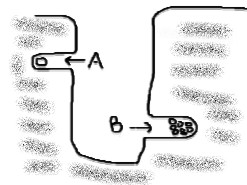
The test diagram
Our earlier tests had proved that the Halo effect of buried coins etc played no
real part in detection depth in fact the halo effect only applies to Iron. To
prove this fact next time you dig an ancient coin try to detect the soil in
which it came out, if the halo effect was true the soil would give off a signal
to.
The silver sixpence was placed in pod "A" the 1kg coin hoard was in pod "B"
(see diagram).
Machines used
Minelabs : Explorer with standard coil, Sovereign with WOT coil, Quattro standard coil
Gold Maxx Mk1
Whites, XLT, MXT
Nexus, std coil, prototype coil
Tejon with big coil and standard coil
The Digging starts
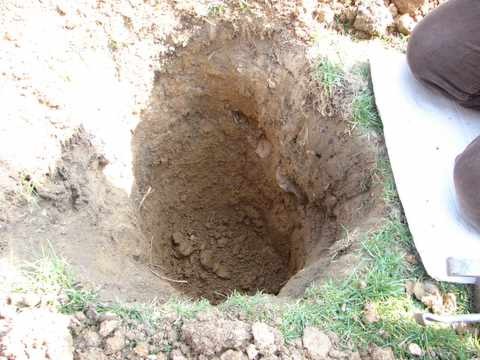
The test hole
It is surprising how hard it was to dig this deep....
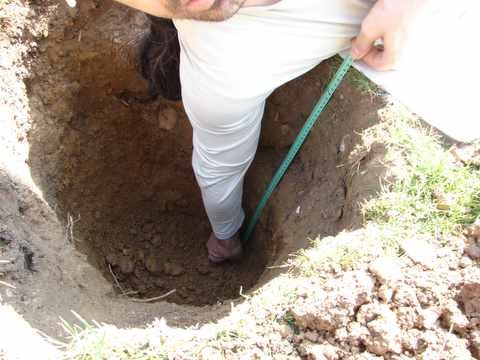

I can't get my head around Centimetres let's try inches
Measurements in inches and centimetres
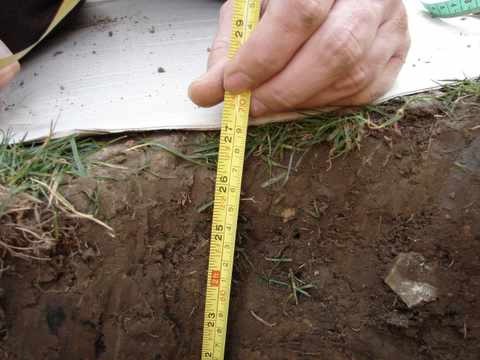
The control a highly conductive Aluminium test piece
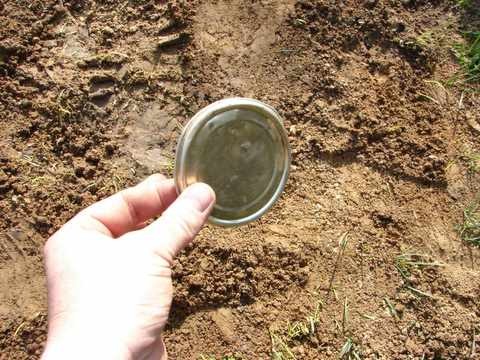
Before we carried out the full test we buried a highly conductive aluminium
piece at the bottom of the hole and the filled it in with the earth and packed it down hard.. Only 3 machines
picked this target up with a faint signal through the disturbed soil. The
Minelabs, Tejon (Big coil), Nexus with std 9" coils.
Conclusion
Loose earth in a freshly dug hole is not a fair test for a machines depth capabilities,
all machines tested would indeed pick the hole up as part of the target
giving a false depth impression.
Then we dug the hole out and placed the aluminium piece in the side pod "B"
and filled the hole again, now we could test it under undisturbed soil.
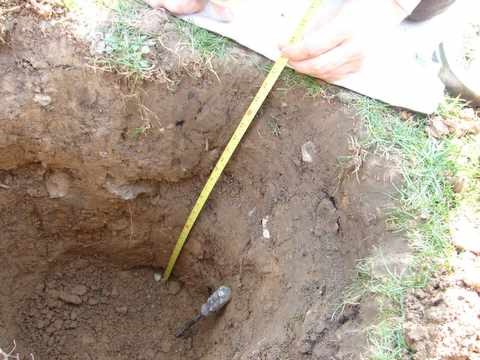
The side pocket "B" is next to the screwdriver
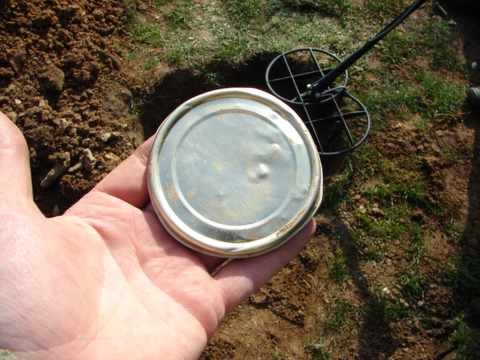

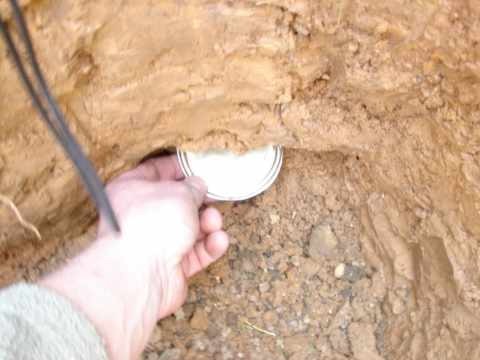
Test Result:
Only one machine could detect the Aluminium target beneath the undisturbed soil.
At 25" deep the Nexus with the 12" coils was the only machine that produced a smooth signal on the large Aluminium.
Now it is time to bury the simulated hoard underneath un disturbed soil...Pocket B
* Note there is still quite a lot of small nails and small iron surrounding the hoard to simulate real detecting conditions.
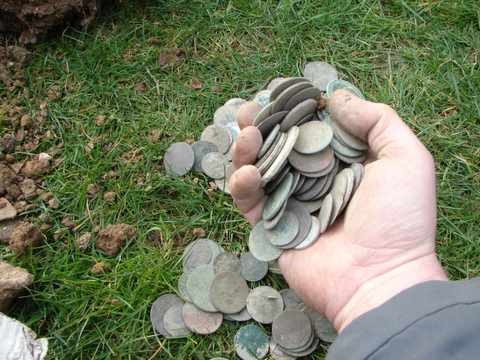
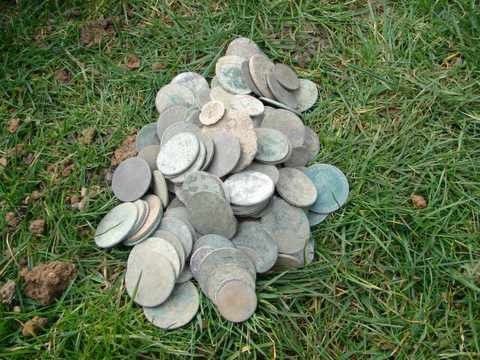
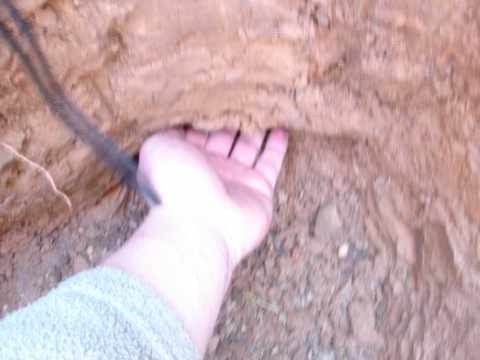
1KG of mixed copper and silver coins some with the original soil still stuck to
them, the coins were placed in pocket "B" and the hole was filled
in.
Ready for the test......One ruined garden
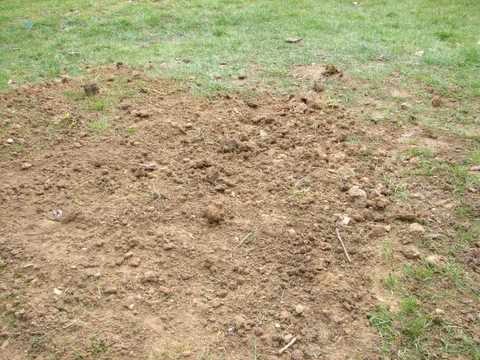
Test results
NO MACHINE COULD PICK UP THE BURIED HOARD
IN DISCRIMINATION
You would have expected the Nexus to pass this test with flying colours but it failed with all the other machines.
So beware of sellers claiming their machine is the deepest hand held detector in the world or words to that effect, there are to many different scenarios to take into account ...it is probably just a get rich quick scam.
The test is now in place for ever, it will be interesting to test new machines in
the future.
Next time someone says they dug a hammered coin at nearly 2 feet simply give
them a tape measure and a link to this page.
Targets can be possibly be detected this deep providing they are
A: Bigger in mass than our test coins
B: Higher in conductivity than the targets used.
Most
Pulse machines and pipe locators up to date have no discrimination (so not a fair test) I
will post results if and when I get one that discriminates iron.
This myth is Busted
Can machines that don't air test well, go deeper in the soil ?
No absolute Crap !! this is scientifically impossible if a
machine air tests badly it will detect badly in the soil
despite what you read on metal detecting forums and some manufacturers
literature.
However some machines that air test better can loose a higher percentage
of depth in the soil around 30% depending on what type of search coil is used.
If you suspect these results are wrong, please go out there and do the buried
coins test for yourself.
I think you will be amazed!!!!.
Letter from reader
Hi Gary,
How refreshing to see the results of your hoard
testing.
I have done a number of tests myself admitted not to the
depths you went .
Here is one:-
I super glued a 12mm dia roman bronze it was approx 1mm
thick on the end of
a 3" piece of 1" dia dowel rod and pushed it into the
ground so the ground
was relatively undisturbed, now this coin had been
checked "in air" with the
(1)--Cibola-----6".
(2)-----Sov gt with 8" coil------8".
(3)---- xterra 50 7.5khz coil---9.5".
(4)----xp goldmax----6".
Result NOT ONE machine gave a diggable signal.
Only the Cibola gave any indication there might be a
target lurking below
the surface. As for the claims that some machines will
detect a target at a
greater distance in the ground than in the air is as
you put
it absolute crap.
My conclusions to this type of testing is that if you
take
all the machines from the top brand manufacturers the
results in the ground
are to a degree very similar with one another and the
only real differences
are the likes and dislikes of the operator, mostly
concerning the weight,
sounds and ergonomics of individual machines. As for the claims made on ebay
from some sellers of detectors it is truly laughable
well it would be if it
wasn't so dishonest.
Anyway Gary love your site
Kind regards,
Ray
|